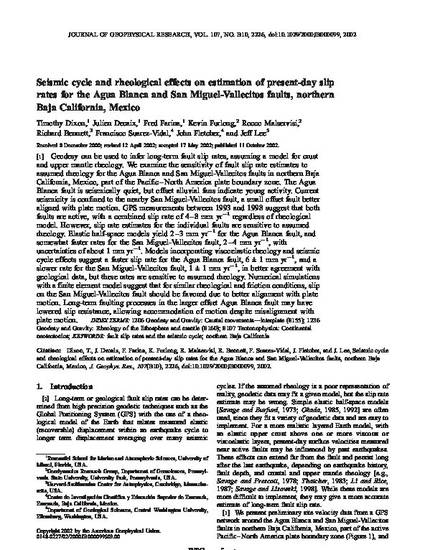
- fault slip rates and the seismic cycle,
- northern Baja California
Geodesy can be used to infer long‐term fault slip rates, assuming a model for crust and upper mantle rheology. We examine the sensitivity of fault slip rate estimates to assumed rheology for the Agua Blanca and San Miguel‐Vallecitos faults in northern Baja California, Mexico, part of the Pacific–North America plate boundary zone. The Agua Blanca fault is seismically quiet, but offset alluvial fans indicate young activity. Current seismicity is confined to the nearby San Miguel‐Vallecitos fault, a small offset fault better aligned with plate motion. GPS measurements between 1993 and 1998 suggest that both faults are active, with a combined slip rate of 4–8 mm yr−1 regardless of rheological model. However, slip rate estimates for the individual faults are sensitive to assumed rheology. Elastic half‐space models yield 2–3 mm yr−1 for the Agua Blanca fault, and somewhat faster rates for the San Miguel‐Vallecitos fault, 2–4 mm yr−1, with uncertainties of about 1 mm yr−1. Models incorporating viscoelastic rheology and seismic cycle effects suggest a faster slip rate for the Agua Blanca fault, 6 ± 1 mm yr−1, and a slower rate for the San Miguel‐Vallecitos fault, 1 ± 1 mm yr−1, in better agreement with geological data, but these rates are sensitive to assumed rheology. Numerical simulations with a finite element model suggest that for similar rheological and friction conditions, slip on the San Miguel‐Vallecitos fault should be favored due to better alignment with plate motion. Long‐term faulting processes in the larger offset Agua Blanca fault may have lowered slip resistance, allowing accommodation of motion despite misalignment with plate motion.
Journal of Geophysical Research: Solid Earth, v. 107, issue B10, art. 2226
Copyright 2002 by the American Geophysical Union.
Available at: http://works.bepress.com/timothydixon/133/

Complete list of authors: Richard Bennett, Francisco Suarez‐Vidal, John Fletcher & Jeff Lee